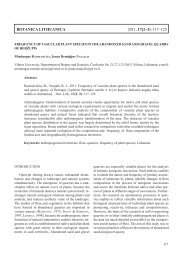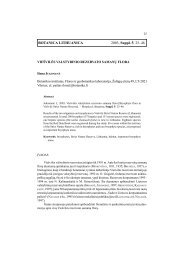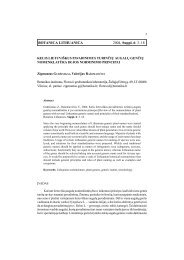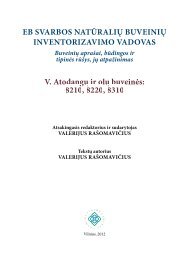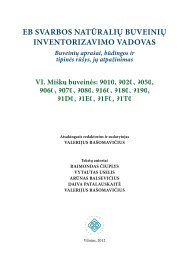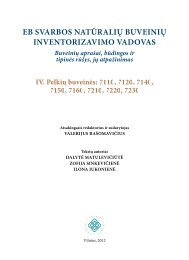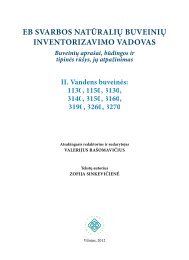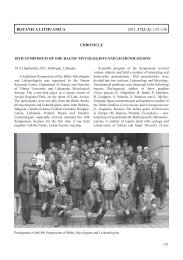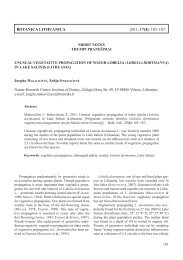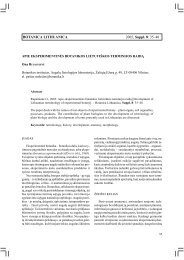FUNGI AND LICHENS IN THE BALTICS AND BEYOND XVIII ...
FUNGI AND LICHENS IN THE BALTICS AND BEYOND XVIII ...
FUNGI AND LICHENS IN THE BALTICS AND BEYOND XVIII ...
You also want an ePaper? Increase the reach of your titles
YUMPU automatically turns print PDFs into web optimized ePapers that Google loves.
FUR<strong>THE</strong>R RESULTS ON CONSERVATION OF LICHENISED <strong>FUNGI</strong> <strong>IN</strong><br />
HUNGARY<br />
E. FARKAS 1 , L. LŐKÖS 2 , K. MOLNÁR 1<br />
1 Institute of Ecology and Botany of HAS, H-2163 Vácrátót, Hungary<br />
2 Botany Department, Hungarian Natural History Museum, Pf. 222, H-1476 Budapest,<br />
Hungary<br />
E-mails: efarkas@botanika.hu, lokos@bot.nhmus.hu, kmcz100@gmail.com<br />
Efforts for legal protection of lichens in Hungary from 1999 to 2004 were summarised<br />
in a former presentation during the XVIth Symposium of Mycologists and Lichenologists of<br />
the Baltic States, Latvia, September 2005. Due to our activities 5 lichen species (Cetraria<br />
aculeata, Cladonia magyarica, Usnea florida, Xanthoparmelia pseudohungarica and X.<br />
subdiffluens) became protected by law (23/2005(VIII.31) KvVM) in August 2005. Further 3<br />
lichen species of the genus Cladina (C. arbuscula, C. mitis and C. rangiferina) were included<br />
in an additional law (18/2008(VI.19) KvVM) for conserving further rare and endangered<br />
organisms in Hungary. However, recent studies emphasize that Hungarian populations of<br />
these species need taxonomic revision urgently. Our forecast about a better understanding of<br />
the importance of biodiversity seems to be fulfilled. We still hope that even more species will<br />
gain protection in future and our results in taxonomy will support conservation of lichenised<br />
fungi.<br />
Acknowledgements. Our work was supported by the Hungarian Scientific Research<br />
Fund (OTKA T47160 and K81232).<br />
SPORE ORNAMENTATION <strong>AND</strong> APO<strong>THE</strong>CIA SURFACE <strong>IN</strong> <strong>THE</strong> LICHEN<br />
FAMILIES Gyalectaceae <strong>AND</strong> Coenogoniaceae<br />
L. V. GAGAR<strong>IN</strong>A<br />
Laboratory of Lichenology and Bryology, Komarov Botanical Institute of RAS, Prof. Popov<br />
Str. 2, 197376 St. Petersburg, Russia<br />
E-mail: kvercus@yandex.ru<br />
The Gyalectaceae and Coenogoniaceae are families of lichenized ascomycetes. The<br />
family Gyalectaceae includes widely distributed species. Coenogoniaceae occur mainly in<br />
tropical regions. Morphology and anatomy of these families is poorly investigated.<br />
The aim of our research is to study the spore ornamentation and apothecia surface in<br />
the lichen families Gyalectaceae and Coenogoniaceae by the method of scanning electron<br />
microscopy. Totally twenty four species were investigated. The spores and apothecia were<br />
examined and photographed in JSM 63 90 LA scanning electron microscope (SEM).<br />
The lichens from families Gyalectaceae and Coenogoniaceae can be divided into five<br />
groups on the basis of spore ornamentation: 1) smooth, without ornamentation – Belonia<br />
herculina, B. russula, Coenogonium luteum, C. pineti, Gyalecta derivata, G. friesii, G.<br />
jenensis, G. kukriensis, G. leucaspis, G. liguriensis, G. schisticola, G. subclausa, G. titovii, G.<br />
truncigena, G. ulmi, Pachyphiale carneola, P. fagicola, P. ophiospora, Ramonia luteola; 2)<br />
with poorly developed ornamentation – Gyalecta flotovii; 3) slightly verrucose – Gyalecta<br />
foveolaris, G. peziza; 4) verrucose – Gyalecta geoica; 5) areolate – Gyalecta nigricans.<br />
Some information concerning apothecia surface has been obtained. Margin surface is<br />
similar for all studied species. According to the disc surface, species were divided into three<br />
main groups:



